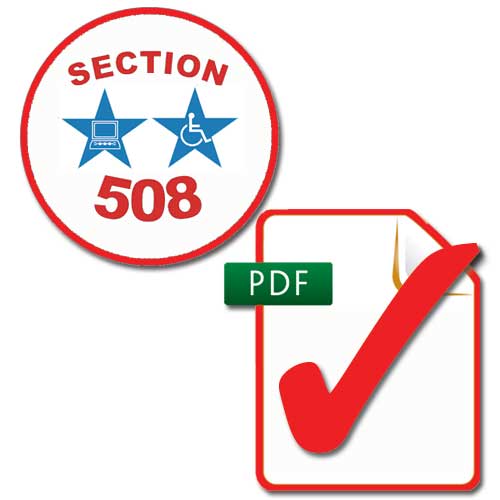Ensuring PDFs are compliant with Section 508 means enabling content for use by devices that suit the needs of a wide variety of disabled users. For those implementing Section 508, it’s important to know what this really means.
This document is a PDF-specific guide to the Section 508 regulations, as adapted from § 1194.22 Web-based intranet and internet information and applications on the Section508.gov website.
Technical Application in PDF:
1st Generation (2001) Section 508 regulations
For software developers, it’s not obvious how Section 508 requirements apply to PDF. What follows is a paragraph-by-paragraph high-level technical overview to implementing Section 508 in PDF files.
NOTE: This is NOT a “best practice” guide for content authors, but instead a technical examination of how 2001 version of the Federal standard should be understood in PDF terms.
 (a) “A text equivalent for every non-text element shall be provided…”
(a) “A text equivalent for every non-text element shall be provided…”
PDF translation: Provide alternate text for every graphic image included in the PDF.
(b) “Equivalent[s] for any multimedia presentation…”
PDF translation: Not applicable for the vast majority of documents., but if you use multimedia, you’ll need alternate text..
(c) “…all information conveyed with color is also available without color…”
PDF translation: May require re-design of PDFs created from electronic source. Treat low-contrast text (shaded areas) as image [see paragraph (a)], or remove shading.
(d) “Documents shall be organized so they are readable without requiring an associated style sheet.”
PDF translation: Not Applicable in the strict sense that PDF doesn’t include style-sheets at all. HOWEVER, the applicable point for PDF here (and it’s crucial) is the idea that “documents…shall be readable….”. This means, in PDF, that they must be tagged, and (minimally) that the tags must be in the correct logical reading order. Interpreted more generously, it also strongly implies that documents must include correct semantic markup such as tags for Headings, Lists and so on.
(e) “…server-side image-maps.”
PDF translation: Applies if the PDF includes hyperlinks that use a server-side image-map. In practice, almost none do (although it is possible).
(f) Client-side image maps…”
PDF translation: Applies if the PDF includes hyperlinks.
(g) “Row and column headers shall be identified for data tables.”
PDF translation: Comply via Tags
(h) “Markup shall be used … for data tables that have two or more logical levels of row or column headers.”
PDF translation: Comply via Tags
(i) “Frames shall be titled…”
PDF translation: Not Applicable.
(j) “Pages shall be designed to avoid causing the screen to flicker…”
PDF translation: Not Applicable, unless you plan to include some flickering movies in your PDF (don’t).
(k) “A text-only page…shall be provided… when compliance cannot be accomplished in any other way.”
PDF translation: An “escape” clause of sorts for pages with extremely complex content; best avoided. Almost no PDF page requires the “paragraph K exemption”.
(l) “When pages utilize scripting languages…”
PDF translation: This is significant for PDFs containing JavaScript, notably when the JavaScript interacts with page-content or performs actions on buttons, fields and the like in order to deliver information to the user.
(m) “…page[s] must provide a link to a plug-in or applet that complies with §1194.21(a) through (l).”
PDF translation: Pages containing links to PDF files must include a link to the Adobe Reader installer, or equivalent.
(n) “… electronic forms … shall allow people using assistive technology to access the … functionality required for completion and submission…”
PDF translation: PDF forms must be tab-ordered correctly, all fields should be properly labeled and field-values must be made explicit in terms of their meaning. If calculations or scripts are operating, providing feedback or other information to the user, such information must be made available to assistive-technology users.
(o) “A method shall be provided that permits users to skip repetitive navigation links.”
PDF translation: This almost never occurs in PDF, but if you develop some exotic PDF with repetitive text-links, you’ll need to pay attention.
(p) “When a timed response is required, the user shall be alerted…”
PDF translation: Doesn’t apply, unless the PDF contains JavaScript that utilizes timed response.
Wondering where to focus?
Here’s a simple guide to the clauses in terms of the work they require for remediation:
(a), (c), (g), (h), (l), (n) – The bulk of the work
(b), (k) – Infrequent or readily avoidable issue
(f), (m) – No problem, easily addressed
(d), (e), (i), (j), (0), (p) – Not applicable in PDF at all
Source: §1194.22 Web-based intranet and internet information and applications.
